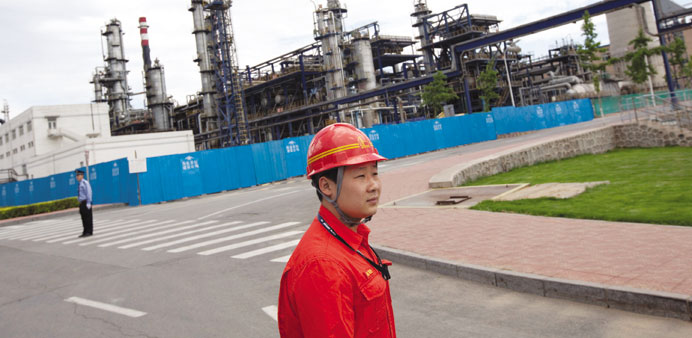Sinopec’s Yanshan refinery in Beijing. Higher purchases by Sinopec mean Iran’s top clients - China, Japan, India and South Korea - are expected to jointly import around 1.25mn-1.3mn bpd in the January-June period.
Reuters/Beijing/Tokyo
China is set to take more Iranian crude than it did before tough sanctions were put in place in early 2012, as Asia’s biggest refiner Sinopec Corp buys more oil from the Middle East nation, sources with direct knowledge of China’s buying strategy said.
Western sanctions over the past few years had reduced Iran’s crude shipments to less than half and crippled its economy by choking the flow of petrodollars. Some of those measures were eased following a breakthrough diplomatic deal last November in return for Tehran curtailing its nuclear programme. Higher purchases by Chinese state refiner Sinopec mean Iran’s top clients - China, Japan, India and South Korea - are expected to jointly import around 1.25mn-1.3mn bpd in the January-June period, according to five industry and government sources with knowledge of oil sourcing in these countries.
“Over the past two years Sinopec had reduced purchases. That was purely because of sanctions,” said an industry official with knowledge of the refiner’s supply plans. “Now that the pressure is eased, they are making the most of it.”
Asked to comment on imports of Iranian oil since late last year through to the first half of 2014, Sinopec spokesman Lu Dapeng said the firm’s “crude purchases are made based on their commercial requirement and the requirement for production.”
Six major powers - the US, Britain, Germany, France, Russia and China - and Iran are trying to reach a final settlement on Tehran’s nuclear programme, although diplomats say a July 20 deadline is likely to slip.
China is likely to import about the same volume of oil in May and June as it did in the first four months of the year, when it took on average of around 620,000 bpd compared with pre-sanctions volumes of around 550,000 bpd.
The Asian giant’s imports are also higher in part because Dragon Aromatics, an independent petrochemicals producer based in Fujian, signed a contract last year for South Pars condensate, a light crude, with monthly purchases averaging at some 80,000 bpd.
In addition, Sinopec is expected to continue lifting full contracted volumes or more. China, Iran’s biggest oil customer, more than doubled its purchases in April from a year ago to a record of nearly 800,000 bpd.
Sinopec’s imports are done via its trading vehicle Unipec. Unipect lifts around 265,000 bpd of Iranian oil under an 8-year oil contract that will last through to end-2019.
The other three Asian buyers are expected to hold imports at levels similar to the first four months, sources said.
Japan is likely to hold its imports steady at around 165,000 bpd compared with the 2013 average of 177,414 bpd.
In the first four months of the year, Japan bought 57,876 bpd of South Pars condensate, more than double the level a year earlier, while it reduced purchases of Iranian Heavy and Forozan Blend by nearly 40% in each case, a breakdown of the Ministry of Economy, Trade and Industry (METI) showed.
The significant increase of South Pars condensate volumes is because the light crude from Iran is much cheaper than other condensate grades, industry sources said.
South Korea, which imported 134,375 bpd of oil from Iran in the first four months of the year, is also expected to retain imports around the same level through June.
“I don’t think there will be any change in the country’s Iranian oil import volumes for a while,” a source at a Seoul-based refiner which imports Iranian oil said.
India lifted 324,700 barrels from Iran in the first four months of the year. The country’s import plans for the first half were not immediately clear, but it reduced purchases in April and should continue to do so in coming months after boosting first-quarter shipments.



